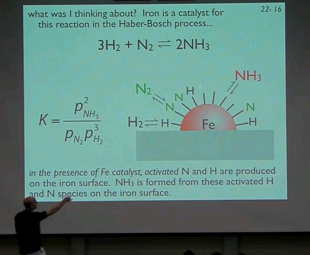UCI Chem 131C Thermodynamics and Chemical Dynamics (Spring 2012)
Lec 22. Thermodynamics and Chemical Dynamics -- Midterm Exam Review --
View the complete course: ../courses/chem_131c_thermodynamics_and_chemical_dynamics.html
Instructor: Reginald Penner, Ph.D.
License: Creative Commons BY-NC-SA
Terms of Use: ../info.
More courses at http://ocw.uci.edu
Description: In Chemistry 131C, students will study how to calculate macroscopic chemical properties of systems. This course will build on the microscopic understanding (Chemical Physics) to reinforce and expand your understanding of the basic thermo-chemistry concepts from General Chemistry (Physical Chemistry.) We then go on to study how chemical reaction rates are measured and calculated from molecular properties. Topics covered include: Energy, entropy, and the thermodynamic potentials; Chemical equilibrium; and Chemical kinetics. This video is part of a 27-lecture undergraduate-level course titled "Thermodynamics and Chemical Dynamics" taught at UC Irvine by Professor Reginald M. Penner.
Thermodynamics and Chemical Dynamics (Chem 131C) is part of OpenChem: ../openchem/
Recorded May 23, 2012
Index of Topics:
00:05 - some announcements
00:44 - Chem 131 C Quiz 6
03:23 - Youtube search for Chem Lectures
03:34 - chemistry lecture page with YouTube link
03:53 - what does Midterm Exam 2 cover?
04:46 - "what does Midterm Exam 2 cover?"
06:12 - Papers about La Chatellier Principle
06:52 - what was I thinking about? The ammonia synthesis reaction is:
08:10 - what was I thinking about? Iron is a catalyst for this reaction in the Haber-Bosch process...
13:38 - Problem I - entropy and the Carnot cycle (see especially Lecture 13)
14:13 - entropy - statistical definition:
14:32 - Diagram: now, there are three flavors of systems:
15:05 - The Carnot Cycle
15:16 - a heat engine extracts work from a temperature gradient.
15:37 - Graph: The Carnot Cycle
16:22 - Graph: ...ANY process can be decomposed into...
18:12 - Graph: What do we know for sure?
19:47 - how efficient is the heat engine?
20:21 - Diagram (work over heat)
20:39 - how efficient is a Carnot Cycle?
22:47 - Graph: ...now this pair...
23:49 - let's prove this...
24:03 - so the total work is:
24:51 - Problem: What is the entropy change...
25:08 - Since S is a state function we can write...
26:08 - so represented in a Temperature-Entropy diagram, a Carnot cycle looks like this...
26:33 - What if one or more steps of the process are irreversible?
27:37 - and a more general statement of this is called the Claussius Inequality
28:19 - This equation makes predictions about 3 types of processes:
28:41 - some simple but important examples:
29:18 - some simple but important examples: example - a reversible phase transition.
29:51 - example - reversible heating/cooling of a gas.
30:48 - rev. expansion/compression of a gas.
31:45 - Calculating entropy changes for reversible processes on ideal gases:
32:26 - because S is a state function...
33:20 - Because S, like U, is a state function, you can add up...
33:53 - Calculate the entropy change when...
36:47 - Problem 2
37:09 - chemical potential of species...
37:38 - really? yes, think about this way ("...partial derivative")
38:24 -...you should know...
Required attribution: Penner, Reginald Thermodynamics and Chemical Dynamics 131C (UCI OpenCourseWare: University of California, Irvine), ../courses/chem_131c_thermodynamics_and_chemical_dynamics.html. [Access date]. License: Creative Commons Attribution-ShareAlike 3.0 United States License.


